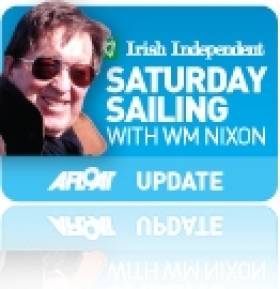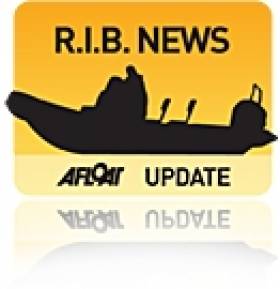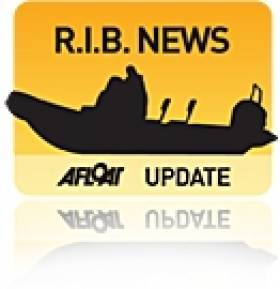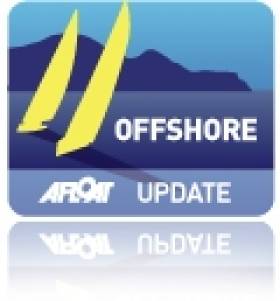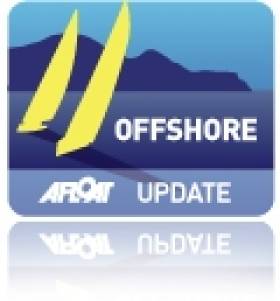Displaying items by tag: Round Ireland
#roundireland – With under two months to the start of the Round Ireland yacht race in Wicklow, Wicklow Sailing Club member David Ryan has chartered the Monster Project, a Volvo 70 class yacht for the race.
Amongst his crew will be the three lucky winners from the national crew competition he organised with the Irish Cruiser Racing Association. Last Saturday at the ICRA Come Sailing Day in Howth, the finalists were chosen. His crew will also feature local Wicklow Sailing Club members and the club itself is delighted to support his venture as the official club entry in the race. David and his crew will set off from Wicklow Sailing Club on June 28th with the goal of winning line honours in the Round Ireland Yacht Race. With the right weather, this team could even challenge the race record.
The Round Ireland Yacht Race promises some of the most challenging conditions that offshore racing has to offer, from the tidal Irish Sea to the open Atlantic ocean.
Designed and built for these challenges in 2007, Monster Project is well-suited to the kind of conditions that competitors in the Round Ireland Race 2014 are likely to encounter. Having spent the last few months in the Caribbean, Monster Project will compete in the Round the Island race before heading off to challenge in the Round Ireland a few days later.
Was This The First Round Ireland Voyage?
Sailing round Ireland, whether cruising or racing, is a fascinating and uniquely satisfying experience for any Irish sailing enthusiast. Who did it first from an Irish port? W M Nixon introduces a possible candidate from 1860.
We try to tell ourselves that cruising round Ireland is no big deal these days. And even though the biennial Round Ireland Race from Wicklow (this year's starts on Saturday June 28th) throws crews straight into whatever the weather happens to be providing on our exposed Atlantic coasts, when you've become accustomed to hearing the tales of extreme sailing off Cape Horn by Volvo racers and the like, Ireland's west coast in summer seems like an old pussy cat by comparison.
Yet despite the all-round sailing abilities of modern boats, the safety and convenience factor provided by reliable auxiliary engines, and the proliferation of new or improved harbours with convenient pontoon berths on every coastline, cruising round Ireland still has the capacity to feel very special indeed. This is particularly so if you allow yourself at least four weeks to do justice to the extraordinary variety of ports, harbours and coastlines that you'll encounter during a voyage which can be 1200 miles long if you give the most interesting areas the attention they deserve.
As for racing round, most Irish sailors would like to have at least one racing circuit in their CVs. Others become almost addicted to the guaranteed satisfaction of being there in the start at in late June in every even-numbered year, while the bonus of completing the course is still magic. And as for getting among the trophies, well, that's simply ecstatic.
The essence of the round Ireland mystique lies in doing it from an Irish port in an Irish boat. The earliest known distance race along the Irish coast occurred in 1860. It was from Dublin Bay to Cork Harbour, with one of the smaller boats winning despite there being no handicaps. This "first of the first" was the 39-ton cutter Sybil (Sir John Arnott), sailed by the renowned amateur skipper Henry O'Bryen. But despite the race being sailed again in 1861, 1862 and 1888, and despite the enthusiasm from the 1850s onwards for "cross channel matches" between the east coast of Ireland, the North Wales/Liverpool area, and the Isle of Man, the notion of a round Ireland race, if it did arise, simply didn't get any significant support, and thus the first race round came as part of something else.
In the extravagant golden days of 19th Century yachting with enormous craft sailed by large professional crews, Ireland might be taken in as part of a circuit cruise of the islands of Great Britain and Ireland. And the first race round all the islands took place in 1887 in an anti-clockwise marathon from Southend in the Thames Estuary, organised by the Royal Thames YC to celebrate Queen Victoria's Golden Jubilee.
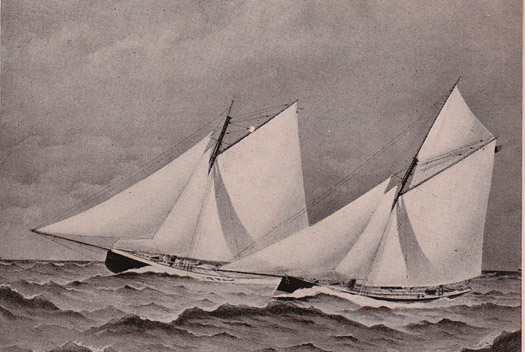
The 80-on Genesta (right) was winner of the first Round Britain and Ireland Race in 1887. She is seen here two years earlier in her unsuccessful America's Cup Challenge against Puritan
In a fleet of eleven starters, the smallest was the 40-ton cutter Sleuthhound, while the largest was the 255-ton schooner Selene. Only six of this pioneering fleet finished, and the winner was the 80-ton cutter Genesta (Sir Richard Sutton), which had unsuccessfully challenged for the America's Cup two years earlier. Inevitably, one muses on the prospects for current America's Cup challengers, successful or otherwise, in sailing this offshore course....But enough, the fact is that this was, in a sense, an early round Ireland race. And as for cruising round Ireland, that doughty cruising trailblazer R T McMullen, a Royal Thames member, had not been permitted to take part in the Golden Jubilee Race as his 16-tonner Orion was considered too small. But he sailed the course anyway as a long high-speed cruising passage, and thus in 1887 we had an early round Ireland "cruise".
So that bit of information goes into the fascination of the story of sailing round Ireland. And the more we know of the pioneering days of sailing, the more we are astonished by what some of the early cruising folk achieved when the sport was undeveloped, and the secrets and local knowledge of the remote coastlines of Ireland, the bits that were barely outlined in the official charts, were jealously guarded by people who didn't want them known. Smugglers and pirates for instance, or those who hoped to sell local knowledge on a regular basis, such as those retained as personal pilots by strangers cruising the coasts.
Then too, the development of cruising round Ireland has been much affected by the turbulent national history. Cruising and simply sailing along the coast are quintessentially activities of peace and prosperity. You need peace to cruise, and you certainly need some level of individual prosperity for the yacht owners themselves, though speaking personally a general air of prosperity ashore when you get to port is something which adds greatly to cruising enjoyment – "picturesque poverty" gives me the creeps
When we first cruised round Ireland in 1964, the western and southwestern seaboards were only just beginning to come to life after many decades of low economic activity, and it was good to see it. But it's much more enjoyable to cruise those areas these days, when – despite the recent recession – there's a lot of life about the place, and local sailing is thriving. And for those who would suggest that it's getting too crowded, I can only say you're not trying. There are many wide open spaces and secluded uncrowded anchorages if you look for them, and have a boat capable of self-sufficiency with proper anchoring arrangements which don't rely on pontoons or visitor's moorings.
But every time you do the circuit, the curiosity about who did it first from an Irish port becomes ever greater. Until the Great Famine of 1845, there had been flowerings of recreational sailing along the Atlantic coasts, with the Royal Western of Ireland Yacht Club emerging from a regatta at Kilrush on the Shannon Estuary in 1829. In an era when those who had wealth and free time had lots of it, and the entertainment industry was in its infancy, the yachts of the time were kept busy.
At its most prosperous, the Royal Western had eighteen substantial yachts based in Kilrush Creek in 1838. It's surely likely that in some seasons their delivery passages to the early regattas in Galway Bay, Belfast Lough, the Clyde, Dublin Bay and Cork Harbour inevitably became round Ireland "cruises". But as the Royal Western faded away in the horrors of the late 1840s, such things were forgotten.
The potential round Ireland sailing craft included another Shannon Estuary boat, the Knight of Glin's notably successful racer Rienvella, a 30-tonner which in 1834 was recorded as winning in both Galway Bay and at Cork. And of course the Corkmen were no slouches in racing and in cruising to races. In 1830 Caulfield Beamish of Cork turned up in Belfast Lough with his cutter Paddy (which he'd designed himself) to race against the boats of the nascent Royal Northern YC, a group which in 1838 became totally Clyde-based, though that is not necessarily attributable to the fact that the Cork boat beat them all back in 1830.
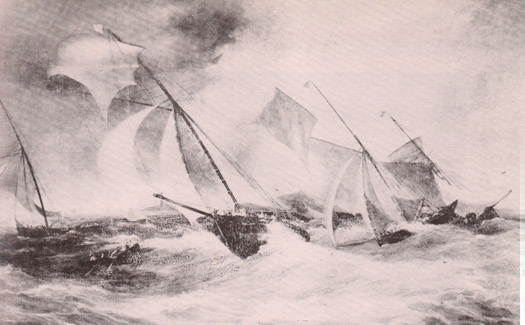
Caulfield Beamish's Paddy from Cork winning a race in hectic style in Belfast Lough in 1830.
Be that as it may, boats like Paddy and other top racers of subsequent decades in the 19th Century regularly made long passages to the main racing venues, and a west coast boat returning from events in the Irish Sea/North Channel area would naturally contemplate going northabout. But while some owners enjoyed doing these voyages, they were thought of as cranks by their peers, who expected inter-event deliveries to be done by professional crews, while the gilded owners just turned up to strut their stuff at the regattas.
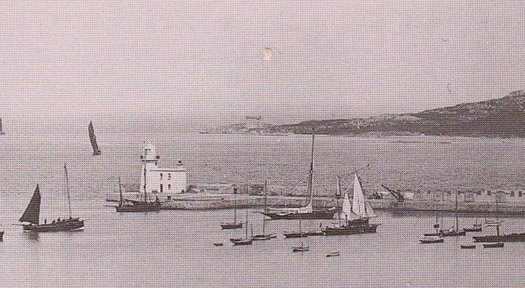
Judge Boyd's 34-ton yawl Aideen on her mooring in Howth in 1889, the year he cruised her round Ireland.
Thus it was a long time before round Ireland cruises as we recognise them today were being undertaken, and for many years the earliest proper round Ireland cruise we definitely knew of wasn't undertaken until 1889, when that great man Judge Boyd of Howth (he figures in Joyce's Ulysses) cruised round in his 34-ton 50ft yawl Aideen. And the only reason we know of it was because it was mentioned in a profile of the Judge in a Yachting Monthly of January 1910. Yet the way it was mentioned suggests that, while rare, by 1889 Round Ireland cruises were by no means a complete novelty. But how on earth to find out about earlier ones?
Enter Wally McGuirk with a Christmas present. The loan of an interesting book may strike you as a weird Christmas present, but when the lender is Wally McGuirk, it's a gem. Wally's business card says it all: "We buy and sell anything marine". He's also a certifiable innovator, and serial boat builder – his current craft, the handsome big steel cutter Swallow, is the eighth boat he has built for himself, and is doubly interesting through being the last boat designed by O'Brien Kennedy.
But that's by the way. Somehow in his mega-busy life, Wally finds time to trawl through second-hand bookshops, and in one in England he came across a facsimile printing of a jewel of early cruising which, to my shame, I'd never heard of, but we'll try to make amends now.
You may know of the Country Diary of an Edwardian Lady, a private journal of 1906 which was a runaway success when it was published in facsimile in 1977. Well, The Log of the Olivia, published in facsimile by Richmond Press in England in 1983 from the original which had come down the ages to distant relatives of the author, is cruising's equivalent to the Country Diary, except that it's even more historically significant as it dates from the period 1859 to 1867. It is the personal sailing diary, illustrated with his own skilled and charming sketches, of one William A Power, who sailed from Kingstown (now Dun Laoghaire) on Dublin Bay in his 25-ton cutter Olivia.

The many voyages of William Power's 25-tonner Olivia from Dublin Bay between 1859 and 1867, which included two round Ireland cruises They sailed so many times through the Irish Sea and the North Channel that they may well have worn a groove in the ocean. "RMYC" refers to Royal Mersey YC, despite the fact that Olivia was based in Dublin Bay, but Power later also listed the Royal Irish as his club.
This excellent facsimile is primarily for print connoisseurs and bibliophiles. As someone who thinks books should be devoured rather than venerated, this is strange territory for me. And equally, in our era of Google, the virtually total blank which was drawn in 1983 in filling in the background to William Power and his fine cruising yacht is almost bewildering. Yet even in 1983, a quick look at the two volume guide to Yachting, first published by the Badminton Library in 1894, would have revealed that Olivia's builder, Michael Ratsey of Cowes, was well known in sailing circles as a boatbuilder and designer, and very active through the middle decades of the 19th Century, with one of his best known racers, the cutter Myosotis, being built as late at 1877.
Thus in being the owner of Olivia, William A Power clearly knew his stuff, but whether he commissioned the boat new or bought her second hand we still don't know. At 25 tons Thames Measurement, she would have been around 45ft in overall length, for the 1860s preceded the era when TM yachts became absurdly narrow and thus unreasonably long in order to exploit the measurement rule.
We can get a very good idea of what Olivia looked at by considering the bare hull of The Nita, which was retrieved from rural seclusion in the Irish Midlands by Hal Sisk and his team in 2006. The Nita was designed and built in iron in 1868 by Bewley, Webb and Co of Dublin for the Dopping-Hepenstal family of Lough Gowna in County Longford. Despite the fact that in her long sailing life The Nita never left the waters of Lough Gowna, she was of an able seagoing shape very typical of her time, and as she too was 25 tons TM, 44ft LOA and 12ft beam, the similarities to the Olivia are remarkable.

The Nita, designed and built by Bewley, Webb and Co in Dublin in 1868. In her dimensions and lines, she is remarkably similar to the Olivia. Photo: Iain McAllister
However, in every other way, the life of the wide-ranging Olivia was totally different. At the moment we know nothing of William A Power except that he was initially recorded in Hunt's Universal Register of Yachts as a member of the Royal Mersey YC (cross-channel inter-club links were strong in those days) and the Royal Western of Ireland YC, which by the 1860s had moved its base from the devastated western seaboard to Dublin Bay. Then Hunt's in 1868 records Power as being a member of the Royal Irish YC, which begins to make more sense, and also the Prince Alfred, later the Royal Alfred YC.
Writing this in the midst of the two week midwinter shutdown, we have no means of accessing membership records of any of these clubs, but it something which will be a fascinating trail to follow. As to William A Power, inevitably you'd guess he was a Power of Power's Whiskey, for the extent of his cruising suggests someone who was on an unearned income. But not an excessively generous one – by the standards of her time, the Olivia was a very modest cruising yacht, and Power cruised her with himself in command, and one or two paid hands, plus any sea-minded friends he can persuade to come along.
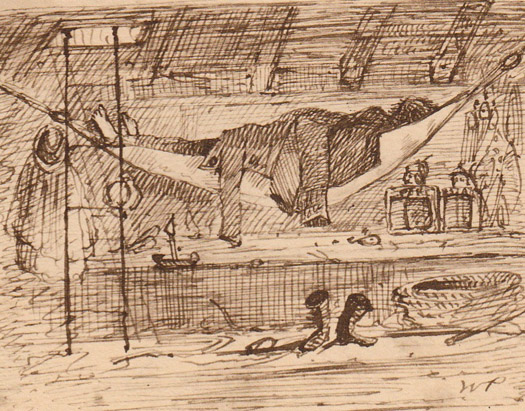
Grabbing some shut-eye in the crew's quarters during Olivia's round Ireland cruise in September 1860. While reasonably comfortable, this was no luxury yacht
Yet despite the limited resources, the cruising he did in the period 1859-1867 was simply sensational. South to Spain, east to Norway, north to the Faroes, and just about everywhere else in between. In a programme like this, in which the Olivia carved her own private roadway up and down the Irish Sea and North Channel, almost inevitably a round Ireland cruise was fitted in, but it seems to have been done in 1860 almost as an afterthought, as the Olivia had already cruised that year north to Orkney and Shetland.
It was Thursday August 30th 1860 when they sailed south from Dublin Bay, so it was a September cruise – not a month normally chosen for a round Ireland venture. And while the coasts they'd visited in the cruises of 1859 and the other cruises of 1860 had been relatively prosperous, the west coast of Ireland in 1860 was anything but.
Thus you get a feeling that the cruise was being done almost out of a sense of duty rather than in anticipation of enjoyment. And as knowledge of any special cruising attractions along the west coast had not yet been assembled in published form, by the standards of today's round Ireland cruises the experiences "enjoyed" by Olivia's crew were very thin indeed. In Cork Harbour, for example, the peak of the season was clearly well past, and up the west coast they were stuck in Cleggan for almost a week as one wet gale followed another.
After three very mixed weeks, they returned to Dublin Bay. But in due course, Power and the Olivia did another round Ireland cruise which seems to have afforded him more pleasure – that's when he did the summery sketch of the boat in Sligo Bay. In a brief initial scanning of this remarkable book, you can very quickly see where the author is enjoying himself – the word count increases and the sketches become lively, whereas when the weather is bad, you can have about four words devoted to an entire week stuck in port.
Power tells it all, including the fact he put Olivia aground on a falling tide in Achill Sound (many cruisers have done the same since), but as he carried legs they were able to keep themselves upright. To pass the time, the crew hunted down a seal that provided a very high protein diet for the rest of the voyage, which reminds us this was a very long time ago - it's surely not something a contemporary crew would contemplate.
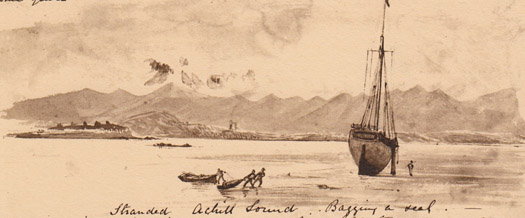
Caught out by a falling tide while straying from the channel in Achill Sound, William Power and his crew put out the legs to keep Olivia safely upright, and then bagged themselves a seal to supplement their diet for the non-stop passage the rest of the way home to Dublin Bay.
All this is just from an initial brief impression of The Log of the Olivia. It was the night before Christmas Eve when Wally appeared out of the dark with this extraordinary book. With 2014 upon us and festivities finally drawing to a close, it's clear that one of the top questions will now be: Who was William A Power? Meanwhile, a prosperous New Year to everyone.
ISORA Attracts More Harbours for 2014 Irish Offshore Sailing Circuit
#isora – The 2014 Round Ireland race brings more interest to a burgeoning Irish Sea offshore scene (ISORA) next June and while ISORA commodore Peter Ryan of the National Yacht Club (NYC) is not proposing to include this 704–mile offshore race in the ISORA schedule there are plans afoot to widen ISORA's traditional reach and move some races at least away from the traditional Dun Laoghaire – Pwllheli race axis.
Conwy in North Wales are keen to host a race start on the 10th May for the up to 30–boat fleet and the response to the Isle of Man (IOM) race last year was huge.
The first May Bank Holiday is the annual Round the IOM race completed during an extended weekend and there is a suggestion this could be accommodated within the trip to and from the Island.
On the Irish east coast Arklow is also a keen location and the new marina at Greystones is also a new venue. In Dublin Bay there are four weekends of regatta races scheduled in 2014. Skerries in North Dublin have expressed an interest and regular ISORA venues at Dun Laoghaire, Howth and Wicklow are all still keen to maintain links across the Irish Sea as are the Welsh ports of Holyhead, Pwllheli and Abersoch. An IRC event is being hosted in August for Abersoch and Pwllheli.
Discussions on featuring the new ports will be a main part of ISORA's agm this month with suggestions already being made that Carlingford in County Lough or Ardglass, Co. Down, situated just south of Strangford, and other Northern Irish Sea ports be considered too.
The annual ISORA AGM will be held in the NYC at 15.00 on Saturday 16th November, same day as the dinner.
Delayed Round Ireland RIB Challenge Heads for Royal Cork
#ribchallenge – 10000hrs Sunday – Afloat.ie just received news from ribber Derek Shaw on Nyzod, a Zodia Pro Open 650, on the RIB Challenge that the fleet is en route to Royal Cork Yacht Club and has just passed the Mizen and estimate possible arrival somewhere between 1pm and 3pm.
Nyzod is the only Irish entry in the challenge and has on board John Garvey an RNLI Cox, Walker Shaw, Richie Cunningham, Donal O'Connor and Paul Lydon.
The Challenge started out with twenty five RIBS and one motor cruiser ranging in size from 4.7m up to 11.5m, a week ago. The fleet met bad weather coming down the west coast and have been stormbound in Dingle, Co. Kerry for the past two days.
RIBs ran into difficulty last Thursday in County Kerry prompting Fenit lifeboat to issue a reminder about how important it is to get an up to date forecast and plan your journey carefully and stay in regular contact with the Coastguard. Fenit ALB launched to assist three ribs which got into difficulty in Brandon bay. Fenit lifeboat took one vessel in tow, and escorted the other two ribs to Fenit harbour.
Organiser of the event Hugo Montgomery-Swan, gave a most graphic description of the conditions encountered by some of the boats approaching Brandon Bay. Seas of ferocious ferocity were encountered with winds whipping and twisting enormous sheets of white water some 300 to 400 feet long and with twisters clearly seen.
The Irish Coastguard were advising and Fenit life boat was tasked and took a RIB that had lost power and was being towed by a fellow challenger, under tow back to Fenit marina. Three boats spent the night there and the second three boats of this party were advised by the Coastguard to make for the safety of a beach inside Brandon where they spent the night on the beach, according to local reports.
Round Ireland RIB Challenge Skipper Thrown From Boat, Rescued by Coastguard Helicopter
#RIB – An air sea rescue for a solo Rigid Hulled Inflatable Boat (RIB) skipper in the Irish Sea got the 2013 Round Ireland RIB Challenge off to a dramatic start at the weekend.
The 24–boat circumnavigation RIB fleet arrived in Dun Laoghaire marina on schedule yesterday afternoon, but one of their number was lucky to be alive after a Search and Rescue operation on Friday plucked a solo skipper from the sea, some nine miles offshore from Milford Haven.
The RIB driver was thrown out of his craft, and a signal from his personal locator beacon was picked up. The incident happened during a crossing from Milford Haven in Wales to the start of the RIB Challenge at Kilmore Quay in County Wexford on Friday afternoon, according to HM Coastguard.
The RIB named Merlin is a Gemini Waverider 4.95m RIB, according to details on the Round Ireland Challenge website.
As Afloat.ie reported on Friday, Falmouth Coastguard contacted Milford Haven Coastguard about a signal from a PLB, (personal locator beacon) located nine miles offshore from St David's Head on Friday afternoon. Coastguard officers checked vessel and contact details on the UK Beacon Registry database and identified that this PLB was registered to Merlin.
Milford Haven Coastguard requested the launch of St Davids RNLI Lifeboat and the rescue helicopter from RAF Chivenor.
The rescue helicopter located the man in the water using the signal from the beacon and winched him into the aircraft. The man was checked by the crew in the helicopter and in agreement with Milford Haven Coastguard returned to his vessel and has made the return voyage to Milford Haven.
He was thrown into the water but was wearing a survival suit, lifejacket and had a PLB with him. The man spent approximately three hours in the water.
Milford Haven Coastguard Watch Manager Rob James says:
"Fortunately this skipper was prepared for a single handed voyage offshore and having the right gear has saved his life. The kill cord on the vessel did work and cut the engine when he was thrown from the boat.
Wearing a survival suit and lifejacket enabled him to survive the three hours in the sea while awaiting rescue and the PLB which was activated sent the exact location of the casualty to the Coastguard."
A tweet from the Challenge organisers on Saturday said Merlin had been 'delayed' and would join the fleet in Dun Laoghaire marina. The fleet, drawn largely from the UK but with Irish, German and Luxembourg entries too, enjoyed an evening at Dun Laoghaire last night and headed north for Bangor marina on Belfast Lough at 9am this morning.
Round Ireland Record – The New Inside Story
#rioti – The further west you go in Ireland, the more it all seems like a giant theatre set. With giant characters to match. We staid East Coast folk could probably cope with it if each of these outsize characters, who aren't necessarily physically large, confined themselves to just one OTT role. But they act out dozens of melodramatic parts. Each individual is a one-man or one-woman cast of thousands. And they've multiple crazy ideas to match.
Plus it's all set in a context where time is meaningless, or at least time is whatever you think it might be, communication seems to be by telepathy, and anything is written down only for the purposes of ignoring it.
In sailing, this western way comes suddenly upon you when you set forth with hope in your heart for an event on the Shannon. I don't mean one of those official events which have proper programmes, and are staged as regional, national or international championships for one design classes, and everything is done according to plan. I mean the quirkier happenings which stem from the nature of the great river and its magnificent lakes, and the unique possibilities which its myriad waters offer for event inventors and organisers whose soaring imaginations tend to out-strip their interest in the tedious nitty-gritty of putting a complex sailing programme together, and particularly of publicising it for those who might be interested in taking part. They tend to suppose that their pet notion is a thing of such beauty that it will acquire its own organisational and promotional impetus. As this becomes apparent, you can only think that the longest river in Britain and Ireland must have come within an ace of being named the River Shambles.
Thus on Thursday on Shannon waters we found ourselves sailing past Rockall. As one does of a Thursday. Or at least one does on Lough Ree. Down there, plumb in the middle of Ireland where they've had a sailing club of some sort in existence since 1770, they've been toying for years with the idea of staging a Round Ireland On The Inside Race, a sort of inverted compliment to Wicklow SC's biennial classic round the outside, as the Lough Ree course planned to go "inside Ireland and all her islands".
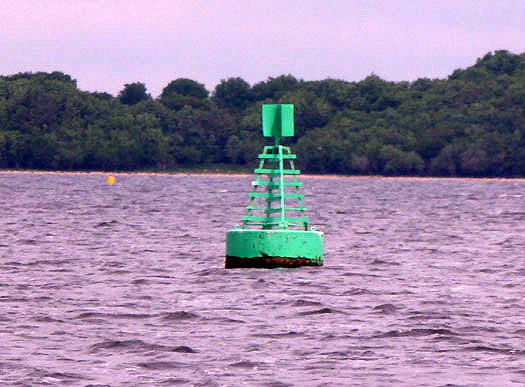
The buoy marking the Adelaide Rock in Lough Ree became Rockall-for-the-Day. Photo: W M Nixon
The two bright boys who have worked up the notion are David Beattie, owner of the 47ft Dutch sailing Lemsteraak Schollevaer, and Lough Ree YC Commodore Alan Algeo, who owns the 84ft Dutch motor barge Linquenda. As both boats had their centenary coming up in 2013, this was to be the year, and I had signed on for a day or three aboard Schollevaer, as the RIOTI event would be in the midst of agreeable cruises-in-company to the many watering holes around Lough Ree.
Unfortunately, the big freeze of a couple of winters ago put paid to Schollevaer's participation, as the ice burst a seacock (and no, I don't know why it's called a seacock on a lake either), and her major refurbishment subsequent to immersion, while almost completed, was going to miss the due date. So no Schollevaer. But not to worry they said, just turn up and we'll find you a berth.
So we drove west through a belt of rain which was lifting to promise a classic day of Irish Atlantic weather and a nice westerly sailing breeze to match, and arrived at Ballyglass to find Lough Ree's fine premises a hive of inactivity. Race Officer Beattie was aboard his other boat, the Shipman 28 Aeolus, looking quite the part in a yachting cap of a type I thought had disappeared after the Hitler Unpleasantness, while contemplating with Buddha-like stillness an array of signal flags which would have been more than adequate for Belfast on a sunny Twelfth of July. But of the Commodore there was no sign whatever. It emerged he was deep in the bilges of Linquenda, sorting a problem with a pump which had been proving inadequate to prevent his ship becoming the second centenarian barge to settle on the bed of Lough Ree within two years.
As for dozens of enthusiastic yachties mustard keen to take on this great challenge of a new Round Ireland Record (Inside Department), there was scarcely a sinner about the place, keen or otherwise. But that's how it is down the Shannon. Eventually it all comes together, and everyone has a great bit of sport. But in a region where the usual dinner arrangement is 8 o'clock for midnight, there's no point in expecting anything that resembles International Standard Time.

Commodore Alan Algeo, having sorted the bilge pump to keep the Commodorial barge afloat for another day, attends to domestic duties in Linquenda's large multi-purpose cabin. Photo: W M Nixon
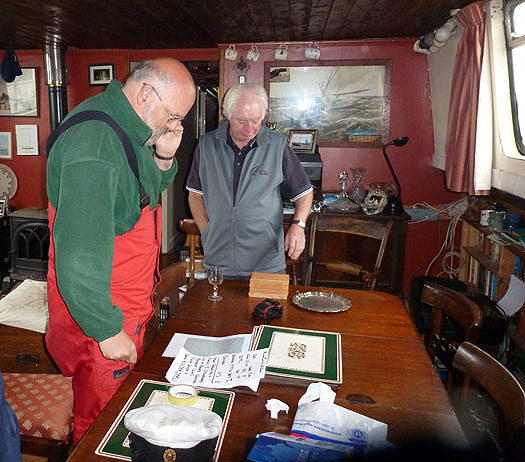
Aboard Linquenda at the saloon table (a family heirloom), Race Officer David Beattie considers course options. Photo: W M Nixon
Eventually the Commodore emerged from a successful interview with Linquenda's bilge pump, and went about his domestic duties in the vast main cabin. There, we were soon joined by the Race Officer who then went through the options and finalised a course. Initial high flown ideas of laying special new marks in order to replicate Ireland's islands and headlands had been long since abandoned, and we made do with navigation buoys and Lough Ree YC's more-than-adequate system of racing marks across the southern half of the lake, the only real adherence to the original idealism being that the starting line in at Hare Island should be in line with the bearing from Wicklow Head. We were also told that with a clockwise course, we'd be leaving the navigational buoys marking the Adelaide Rock to starboard, and that for the purposes of this event the Adelaide Rock would be re-named Rockall.
Apart from it being politically contentious as to just who – if any – has a right to claim Rockall as national territory, this meant that we would be going outside Rockall-for-the-Day, when all the talk had been about going inside Ireland and all her islands. Then too, a worthwhile course meant we went round – in other words outside – gallant little Beam Island in the south end of the lake. But on this being pointed out, it was airily dismissed on the grounds that among Lough Ree sailors, Beam Island is regarded as The Actual Centre Of Ireland, so even a race going round the inside would just have to go round the outside of Beam island. Simple, really.
The course was a coastal circuit of the southern part of Lough Ree, starting and finishing at Hare Island on a line set on the bearing from Wicklow Head, with Beam Island the only island enclosed by a course which otherwise went "inside Ireland and all her islands".
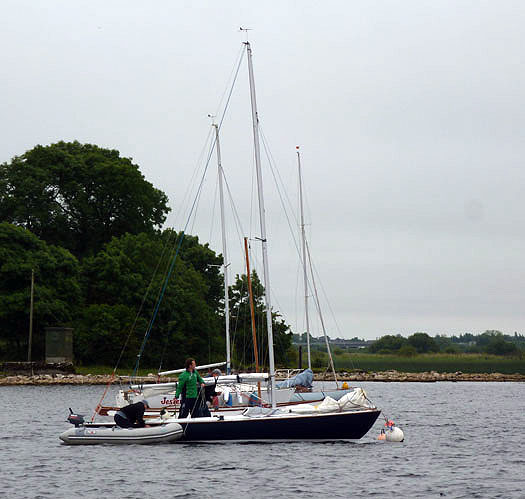
The hot contender – Philip Watson's very souped-up Ajax 23 Pathfinder on her mooring at LRYC Photo: W M Nixon

The Race Officer geared for action in full dress uniform Photo: W M Nixon
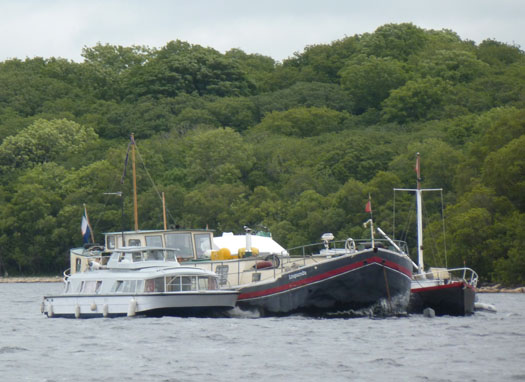
Spectator boats and motherships centred on Linquenda Photo: W M Nixon
The fleet taking on this challenge for the first time made up in quality and variety anything it lacked in numbers. The star turn was undoubtedly Cathy MacAleavey, one of the Lakota crew whose Round Ireland Record (Outside Section) of 1993 still stands after all the faffing about by the MOD 70s in Dublin Bay last weekend. But far from taking on the inside record with some fancy multi-hull, as the start time (whatever it might eventually be) was approaching, Cathy was sailing down the lake from Lecarrow to compete with the classic Water Wag which she built with the tutelage of the great Jimmy Furey at that remote Roscommon port.
The Shannon One Designs were also making a pitch, and from the deep south and the mysterious and mountainous coasts of Lough Derg had come Reggie Goodbody with his elegant gaff sloop Amaryllis as mother ship for his impossibly superb Shannon OD, complete with million carat gold cove line. As for the white-hot keelboat division, elapsed time favourite had to be Philip Watson crewed by Roger Cagney with the Ajax 23 Pathfinder, which he has souped up in such style that you'd scarcely recognise her as the Squib's big sister - he even sets a masthead genniker which certainly puts the cat among the Three Jolly Pigeons down on the coast of the Goldsmith country.
It was in the cruisers I found myself a berth. John Banim was planning to put in a show with his Evasion 29 La Reveuse crewed only by his lakedog Rex, but it was decided Rex could sail as passenger, and we'd challenge for the Cruisers Two-Handed Division. It was a shrewd career move, as no other cruiser had only two men and a dog aboard. And this was one interesting cruiser. Most folk would think she's only a glorified motor-sailer, but back in 1980 Andre Beneteau designed, and his family firm built, this 29-footer which really does sail, yet provides accommodation to commodious motor-boat standard, with a comfortable dining area where the windows are so arranged that you can see out without having to stand up, which is not always the case with fancy deck saloons.

John Banim's Evasion 29 La Reveuse was the only boat in RIOTI which had also sailed round Ireland on the outside. Photo: W M Nixon
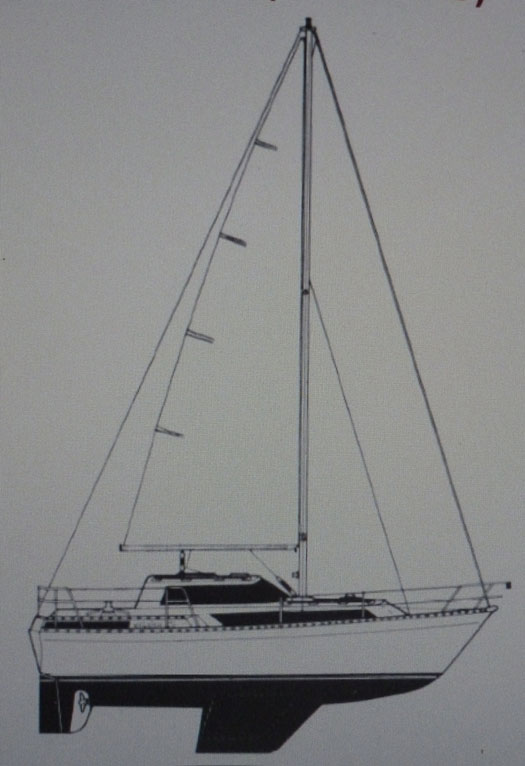
The Andre Beneteau-designed Evasion 29 is a motor-sailer which really can sail

The accommodation on La Reveuse is extremely good for a boat of this size
There are dual steering positions, and thanks to extensive windows and decklights, you really can sail the boat from below, the only drawback being that the cockpit's tiller steering and the saloon's wheel steering cannot be de-coupled from each other, which makes the tiller steering seem much heavier than it really is, though the powerful wheel is fine. That said, for family use you'd wonder at the safety of having a tiller and steering wheel which can suddenly turn when the other method is being used – children might get caught up in it, but it hasn't been a problem this far.
As for seagoing ability, La Reveuse proved herself with a round Ireland cruise – starting and finishing at Kilrush in the Shannon Estuary - in 2002. She experienced some rough weather, particularly on a passage from west Mayo to Killybegs, yet John and his crew never felt that the big coachroof and extensive windows were at risk. And thanks to that cruise, this was the only boat taking on the RIOTI challenge which had also sailed round on the outside.
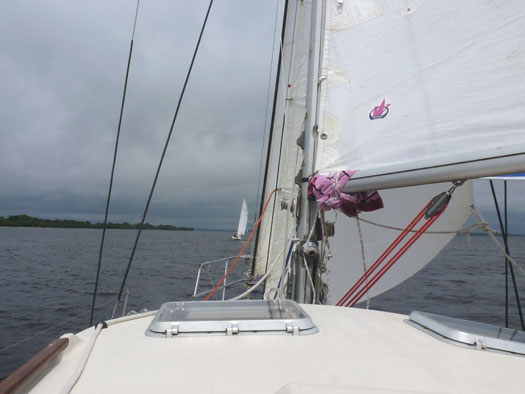
In the early stages of grey weather sailing, Ventus (with Pathfinder even more distant) seemed to be building up an unassailable lead on La Reveuse. Photo: W M Nixon
As for the course, using the LRYC marks and some navigation buoys it was simply a coastal circuit right round the lower part of the lake, staying south of Nun's Island, with only Beam island consigned to the inner darkness. With the rain well cleared to the east, the breeze piped up from the west, and though it slackened at mid-afternoon in grey conditions, it soon came back brisk and fresh with sunshine to provide great sailing, with Lough Ree and its vast skies at their summertime best.

Lakedog Rex wasn't too sure he liked this racing business, but with the skipper busy on the helm, he was able to enjoy the usually off-limits comfort of the best settee berth. Photo: W M Nixon
It was no surprise that Pathfinder did a horizon job on the rest of us, but as we were later to discover, she'd a handicap so punitive she'd have had to finish almost before the rest of us had started if she was going to win on corrected time. Aboard Le Reveuse, we'd resigned ourselves to crossing the finish line third, as Pat Mahon's GRP Folkboat Ventus worked ahead – particularly to windward – in the first of the two rounds. But as we got to the bottom end of the lake for the second circuit, the breeze freshened and blew away the clouds, and our gallant little tubby cruiser settled to her work in the sunshine, and powered northward on a close fetch along the Roscommon shore to such good effect that as we were passing Rockall-for-the-Day for the second time, La Reveuse was dumping on Ventus, and we rounded the furthest turn at the Cribby Islands buoy a whisker ahead.

Final leg southward down the Westmeath shore. Once he'd got through Pat Mahon's Folkboat Ventus.................
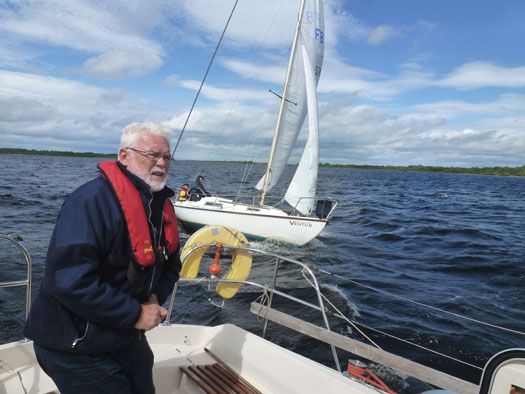
............skipper John Banim was very determined to stay ahead. Photos: W M Nixon
La Reveuse managed to hang onto it – though only just - through a brisk run and reach back to the finish. The line crossed, Rex on his settee berth below could sense the easing of tension, and bounded out into the cockpit to find the new RIOTI Two-Handed Cruiser Champions high-fiving with exuburance.
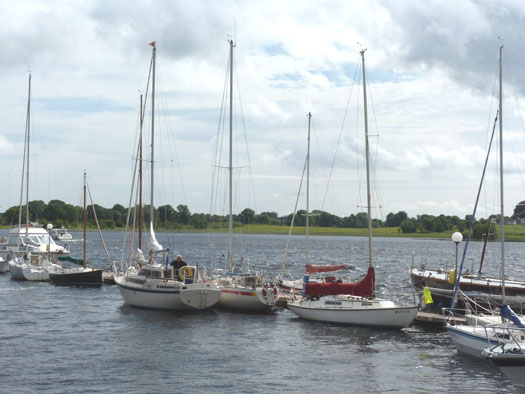
Summer evening post-race at Lough Ree YC Photo: W M Nixon
The classes had got well strung out, and we'd been busy enough with our own work without trying to pay attention to the dinghies, but it was clear that one of the Shannons had sailed a mighty race, and it was Frank Browne of Portlaw in County Waterford who won by a country mile, while in the Water Wags, Ian Malcolm of Howth managed to finish ahead of Cathy McAleavey.
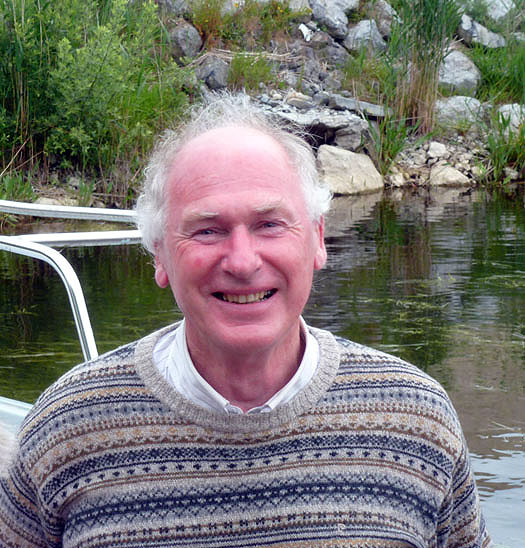
Frank Browne had a mighty win in the Shannon One Designs Photo: W M Nixon
It may have seemed a bit chaotic beforehand, but in the best Shannon traditions it all came together, and we even had an official set of results well before sunset. They were:
RIOTI 2013
Keelboats & Cruisers: lst Ventus (Folkboat, Pat Mahon) CT 2hrs 11mins 44 secs; 2nd La Reveuse (Evasion 29, John Banim) 2hrs 15mins 6secs; 3rd Pathfinder (Ajax 23, Philip Watson) 2hrs 21mins 13secs
Shannon ODs: 1st No 86 (Frank Browne); 2nd No 138 (Alan Algeo); 3rd No 58 (Daphne Shackleton).
Water Wags: 1st No 8 (Ian Malcolm), 2nd No 41 (Cathy McAleavy).
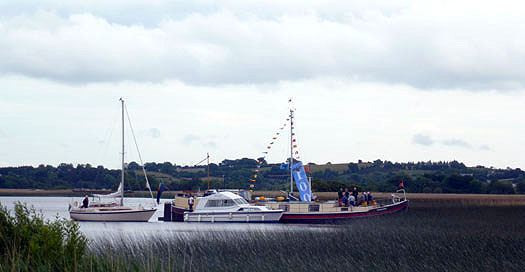
Linquenda and friends ensconced in the reeds to begin her Centenary Party in Killinure Lake Photo; W M Nixon

Rachel Leech's much-travelled Ebenhaezer – recently returned via the Grand Canal from the Old Gaffers Association Golden Jubilee in Dublin – joined the Linquenda RIOTI party at Glasson Hotel. Photo: W M Nixon
The racing disposed of, the fleet re-convened along with Rachel Leech's much-travelled 64ft Dutch barge Ebenhaezer in one of the sweetest places on the Shannon, the little harbour in the northern end of Killinure Lake at Glasson Hotel & Country Club. It's ironic that this idyllic spot is at an establishment which majors in golf. But it provided a sumptuous Linquenda Centenary Dinner, and appropriate celebration for the establishment of the first Round Ireland On The Inside Record, which is held by Philip Watson and Roger Cagney regardless of where they might have finished with Pathfinder on handicap.
This weekend, the inland waterways racing is back in the numbers game in every way, with the annual Long Distance Race in two stages today and tomorrow, down the Shannon from Lough Ree to Lough Derg. Then the next major happenings are the traditional regatta weeks on Derg and Ree, while the Shannon One Designs have other events on their calendar including an outing to Lough Corrib, which some would argue is the most beautiful lake of all.
With so much going on, you can see why it was so difficult to fit a new event like RIOTI into the programme. So whether or not it will happen again is anybody's guess. Maybe it would be better just to remember it as one stand-alone perfect day's sailing. For RIOTI 2013 was that and more.

Shannon ODs looking more beautiful than ever at Glasson Photo: W M Nixon
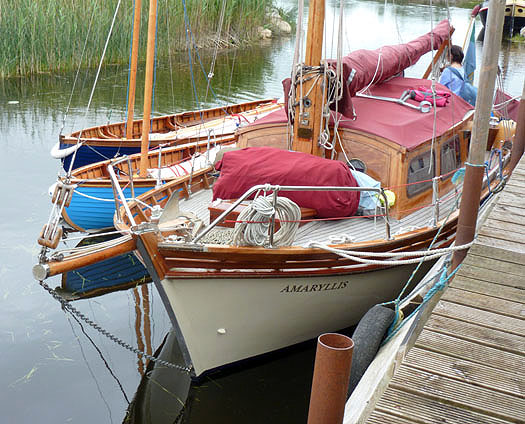
Reggie Goodbody's characterful Amaryllis from Lough Derg will be returning home to Dromineer this weekend after the long distance race down from Lough Ree. Photo: W M Nixon
Galway Offshore Racer Achieves Perpetual Motion
"Harbour rots ships and ruins men". So said Horatio Nelson. He not only knew it from his own extensive command experience, but from time to time during long stays in port, he proved it personally with cringe-making results. He should have remembered that other saying of the sea: A busy ship is a happy ship. And at a more basic level, surveyors and boat maintenance experts will tell you the simple truth, that boats and their equipment usually don't get worn out, but they slowly rot through disuse.
With modern materials, it's not rot as they'd have known it in Nelson's day. But whatever you might call it, it makes things non-functional. Yet a boat which is on the move - sailing regularly and extensively - soon has everything working sweetly, for the demands of the sea are such that the attitude of "sure 'twill do" soon provides its own come-uppance.
Out in the west, they've an attractive boat which is making a fair bid to be a perpetual motion machine, with everything functioning smoothly. It's not that long ago that Martin Breen of Galway bought the Reflex 38 Lynx, but since then she has been in the frame in so many major offshore events, and under so many different sponsorship names, that you could be forgiven for thinking he's owned her for more than a decade, and that there are two or three different boats involved.
At the time he bought her, we noted that she seemed to be the ideal size of boat for Irish conditions. The First 40.7, globally the most successful production-built frontline offshore racer of the past twenty years and a super boat with it, is just that little bit too big for Irish conditions in terms of personnel demands and maintenance requirements. But if you go down to some of the hotter 36ft and 34ft machines, you often find you're missing the boat in terms of catching tidal patterns, and the basic realities of seagoing comfort, even though the brilliant J/109 frequently proves otherwise.

Settling in shortly after the start of the Dun Laoghaire to Dingle, 2011
But 38ft LOA - that is just spot on. When Christian Stimson created what is now the Reflex 38 in 1998, he came up with a concept which has withstood the test of time. She can sail up to her rating, and has proven a steady and successful performer in a wide variety of conditions, proving that the comment by Robert Scheidt - that sailing is a consistency sport - applies every bit as much offshore as in the bays.
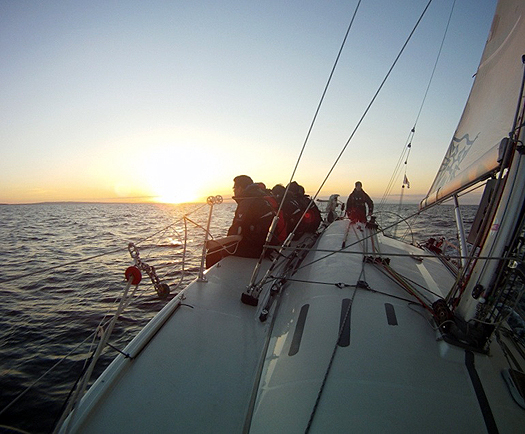
Successful debut. Dawn comes gently over the boat in winning mode in the Dun Laogaire-Dingle Race 2011

Pre-start manoeuvres off Wicklow at the 2012 Round Ireland Race
The new Breen boat made her Irish debut with the Dun Laoghaire-Dingle Race in 2011, and really stuffed it into the fleets from other Irish coasts, for she raced as Galway Harbour, and had an excellent overall win. Then last year it was active members of NUI Galway SC past and present who took her over under the leadership of Cathal Clarke, and they became the ICRA Boat of the Year with a superb all-round programme which included a class win in a major ISORA race, and the class win – including beating the hottest Reflex 38 from Britain – in the Round Ireland Race.
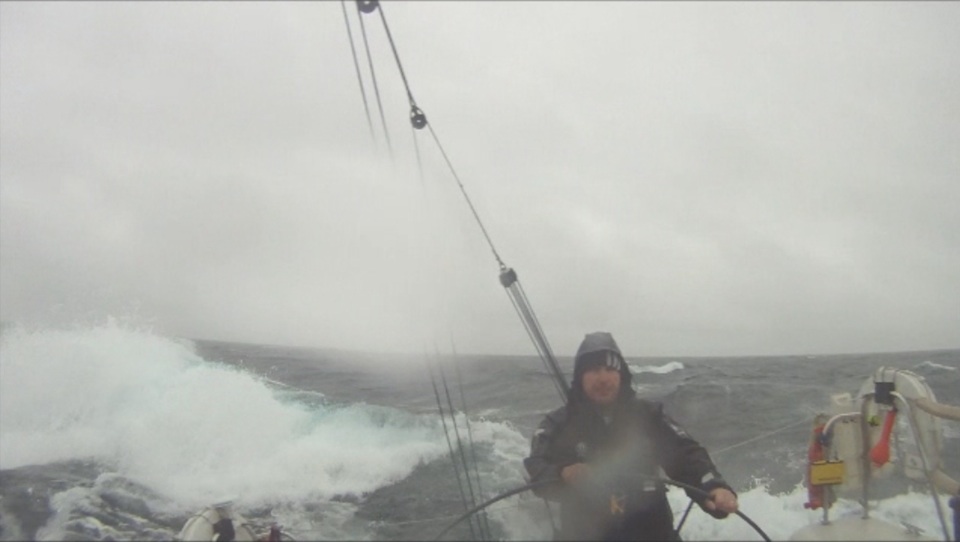
Not always sunny – determined conditions in the Round Ireland Race 2012
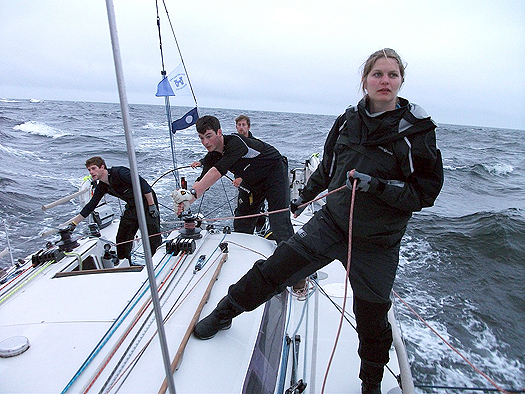
Grey day at sea, Round Ireland Race 2012, with Joan Mulloy from Mayo SC trimming the spinnaker
Between times, the boat didn't rest, as Martin Breen has his own crew for inshore regattas. But this year, the pace is into an even higher gear with Aodhan Fitzgerald (who has been involved since the boat first reached Ireland) in overall charge offshore in a programme which is simply mind-boggling. It was launched yesterday evening in Galway with the boat now in the Discover Ireland livery, and she'll be promoting the Emerald Isle and The Gathering Cruise in a series of campaigns which start today off Rinville at 1000hrs with the 60-mile Clarenbridge Crystal Race in Galway Bay. The crew will be clad from head to toe in new kit provided by Dubarry, with the boat setting a fine new set of threads from Des McWilliam, saling in conditions which look most unlikely to include any calm spots.
Then it's off to Scotland round Ireland's bumpy nor'west corner for the Scottish Series from May 24th to 27th with the boat to be raced by Martin Breen's GBSC team, then south to Dun Laoghaire to be on station for defending the Dun Laoghaire to Dingle title, starting the 266 mile course (which is also a Fastnet qualifier) on June 7th, then on from Dingle it's immediately into the WIORA and ICRA championships just round the corner at Fenit on Tralee Bay, then before June is out, they're challenging for the Sovereign's Cup in Kinsale.
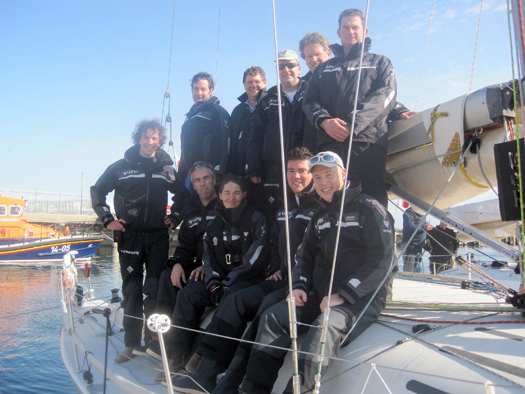
The gang's all here – the 15-strong crew panel's select offshore squad
The total crew panel is 15, ranging in age from 19 to 55, and for the offshore programme the lineup is Aodhan Fitzgerald (skipper/navigator), Johnny Murphy (tactician/trimmer), Neil Spain (driver), Ben Scallan (driver), Martin Breen (driver), Cathal Clarke (bowman), Joan Mulloy (trimmer), Nigel Moss (trimmer), Ruairi de Faoite (mast), and Louis Mulloy (bowman).
While the crew emphasis is on Connacht, in the way of offshore racing this team also includes people from most other parts of Ireland, people that you'd meet in the course of other campaigns, people who seem to fit in with your own boat's way of doing things. If you tried to delineate a clear career path on how to become part of a group like this, you'd find it very difficult. There is no clearcut way. It seems to happen by a mixture of telepathy and osmosis. You are impressed by the way people are sailing another boat, and you make it your business to get them inside your tent.
Because for sure, the business of successfully balancing different temperaments is going to be paramount in a season in which they're only getting going as the Sovereign's Cup draws to a close. The high point of the year is going to be the Rolex Fastnet Race in August. By the time the boat gets to Cowes, she'll have sailed more than a thousand miles in delivery trips.
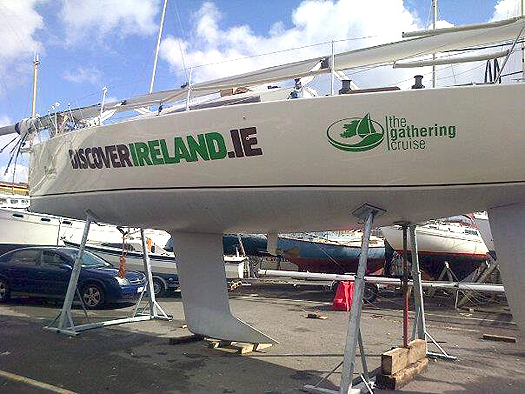
Stating the obvious? Starting the Rolex Fastnet Race with this message emblazoned on your topsides is going to invite ribald comment from the opposition. But displaying something similar has proven successful in the past.
And there she'll be in the Solent among 350 other Fastnet wannabees, with Discover Ireland boldly displayed along her topsides. They'll be getting some smartass comments about that. After all, what else is the Fastnet Race all about? Back in 1975, when the Golden Jubilee Fastnet Race included a fleet for classics racing for the Iolaire Block presented by Don Street, one splendid old gaff cutter had her crew all kitted out in crisp new T-shirts, each one imprinted with different letters. When they all lined up along the rail, those T-shirts read: "What is the way to the Fastnet Rock, please?" In Irish. And it worked. They won the Iolaire Block, even though Iolaire was herself racing. So let's hope that having discoverireland.ie emblazoned prominently on the topsides is going to be equally successful in the Fastnet Race for the boat formerly known as Lynx.
What with this extraordinary campaign, and the news this week about Galway plunging ahead with its new harbour, it's very clear that in the 21st Century, it's totally superfluous to warble on about the west being awake. For a long time now, it hasn't been asleep.
Comment on this story?
We'd like to hear from you! Leave a message in the box below or email William Nixon directly on [email protected]
WM Nixon's Saturday Sailing blog appears every Saturday on Afloat.ie
Follow us on twitter @afloatmagazine and on our Afloat facebook page
#roundireland – After spending last Friday night in the lee of Mount Snowdon, with 35-50 knot winds and rough seas off the Welsh coast, Team Oman Sail called it a day on their ill-fated record attempt and headed back to France early on Saturday morning.
Steve Fossett's 1993 record lives on but Irish crew man Damian Foxall has promised to return and make another attempt.
If the ultra fast MOD70 trimaran gets the right conditions it is estimated as much as ten hours can be shaved off the 1993 Lakota 44 hour record, thanks to new sailing technology.
For now though, Omansail continues its three week training session (part of a build up to the Round Europe race) back in Lorient, France.
'On Tuesday we are out testing with the new Tri Prince de Bretagne', Foxall told Afloat.ie
The following week three MOD 70's go to the training centre in PLF, Oman Sail will line up with Gitana and hopefully Jean Pierre Dick's new MOD 70 Paprec Virbac.
'We've a good season ahead, a couple of short Breton races, three more training sessions, then the Round Europe with a stopover in Dublin, the Fastnet'
The miles flow easy under the MOD 70 hulls and with Foxall's commitment it look's like Omansail will certainly be back for the Fossett record.
#roundirelandrecord – A change in weather forecast has led Kerry sailor Damian Foxall to postpone his bid to beat the Round Ireland speed sailing record for 24 hours. The Oman Sail trimaran craft skippered by Sidney Gavignet is now set to arrive from France on Friday 22nd off the Kish lighthouse on Dublin Bay. The 20-year old record set by Steve Fossett in 1993 stands at 44 hours.
Foxall and his five man crew (who may yet be joined by an Irish sailor) have identified strong easterly winds gusting to over 40 knots to start the record bid. XC weather forecasts strong East South East winds for 72 hours from late on Thursday.
The National Yacht Club in Dun Laoghaire will officiate the World Speed Sailing Record bid under its Irish commissioner Chris Moore.
Foxall's Bid at Round Ireland Speed Record Starts Thursday
The MOD 70 Oman Sail, a giant trimaran will attempt to break the non-stop Round Ireland Speed sailing record starting in two days time. As previously reported Ireland's Damian Foxall confirmed to Afloat.ie this morning the bid to beat the 20-year record held by the late Steve Fossett's Lakota will more than likley start off the Kish lighhouse on Dublin Bay.
The professional crew are out to beat the one day, 20 hour and 42 minute record that has stood since 1993. To do it they must average more than 15.84 knots for the entire 700-mile voyage.
Foxall and a five man crew led by France's Sidney Gavigonet can opt to circumnavigate the country in either direction. The crew expect to encounter 40–knot winds for a time after the start according to the latest forecasts for the Irish Sea on Thursday.
According to the world speed record council (WSSR) there is only one record for whatever direction the multihull takes so she may sail north or southabout around Ireland.
Under WSS rule 20d the the only approved starting/finishing line is: Dun Laoghaire: between the light on the south pier: 53° 18.1' N; 6° 07.6' W and Kish Lighthouse: 53° 18.7' N ; 5° 55.5' W
The course must enclose the whole of Ireland and the following islands or rocks:Rathlin Is, Tor Rocks and Gulf Is, Tory Is, Eagle Is, Tearaght Is, Great Skellig, Fastnet Rock, Coningbeg Rock, Tuskar Rock.



























